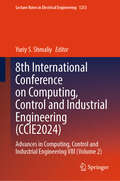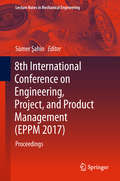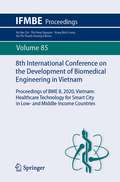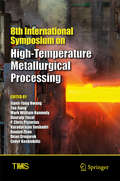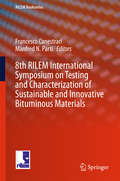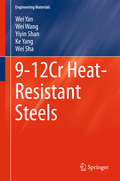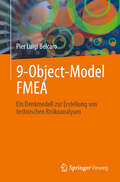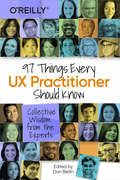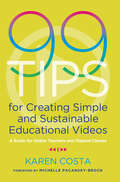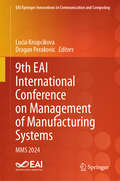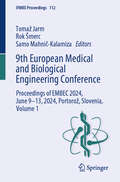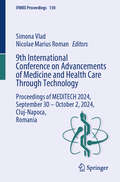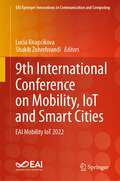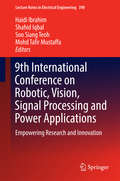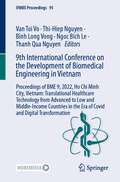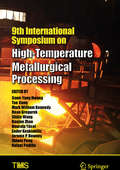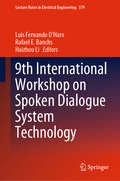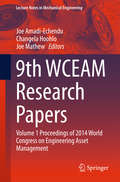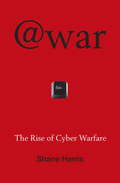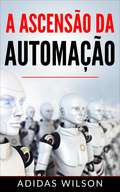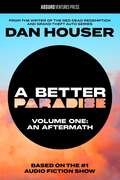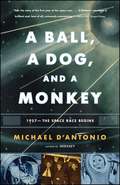- Table View
- List View
8th International Conference on Computing, Control and Industrial Engineering: Advances in Computing, Control and Industrial Engineering VIII (Volume 2) (Lecture Notes in Electrical Engineering #1253)
by Yuriy S. ShmaliyThis book collects selected aspects of recent advances and experiences, emerging technology trends that have positively impacted our world from operators, authorities, and associations from CCIE 2024, to help address the world’s advanced computing, control technology, information technology, artificial intelligence, machine learning, deep learning, and neural networks. Meanwhile, the topics included in the proceedings have high research value and present current insights, developments, and trends in computing, control, and industrial engineering.
8th International Conference on Engineering, Project, and Product Management: Proceedings (Lecture Notes in Mechanical Engineering)
by Sümer Şahin<P>This book presents the proceedings of the 8th International Conference on Engineering, Project, and Product Management (EPPM 2017), highlighting the importance of engineering, project and product management in a region of the world that is in need of transformation and rebuilding. <P> The aim of the conference was to bring together the greatest minds in engineering and management and offer them a platform to share their innovative, and potentially transformational, findings. The proceedings are comprehensive, multidisciplinary, and advanced in their approach with an appeal not only for academicians and university students but also for professionals in various engineering fields, especially construction, manufacturing and production.
8th International Conference on the Development of Biomedical Engineering in Vietnam: Proceedings of BME 8, 2020, Vietnam: Healthcare Technology for Smart City in Low- and Middle-Income Countries (IFMBE Proceedings #85)
by Vo Van Toi Thi-Hiep Nguyen Vong Binh Long Ha Thi Thanh HuongThis book presents cutting-edge research and developments in the field of biomedical engineering, with a special emphasis on results achieved in Vietnam and neighboring low- and middle-income countries. Covering both fundamental and applied research, and focusing on the theme “Healthcare technology for smart city in low- and middle-income countries,” it reports on the design, fabrication, and application of low-cost and portable medical devices, IoT devices, and telemedicine systems, on improved methods for biological data acquisition and analysis, on nanomaterials for biological applications, and on new achievements in biomechanics, tissue engineering, and regeneration. It describes the developments of molecular and cellular biology techniques, and statistical and computational methods, including artificial intelligence, for biomedical applications, covers key public/occupational health issues and reports on cutting-edge neuroengineering techniques. Gathering the proceedings of the 8th International Conference on The Development of Biomedical Engineering in Vietnam, BME 8, 2020, Vietnam, the book offers important answers to current challenges in the field and a source of inspiration for scientists, engineers, and researchers with various backgrounds working in different research institutes, companies, and countries.
8th International Symposium on High-Temperature Metallurgical Processing (The Minerals, Metals & Materials Series)
by Dean Gregurek Baojun Zhao Tao Jiang P. Chris Pistorius Jiann-Yang Hwang Varadarajan Seshadri Mark William Kennedy Onuralp Yücel Ender KeskinkilicThis collection features contributions covering the advances and developments of new high-temperature metallurgical technologies and their applications to the areas of: processing of minerals; extraction of metals; preparation of metallic, refractory, and ceramic materials; treatment and recycling of slag and wastes; conservation of energy; and environmental protection. The volume will have a broad impact on the academics and professionals serving the metallurgical industries around the world by providing them with comprehensive coverage of a wide variety of topics.
8th RILEM International Symposium on Testing and Characterization of Sustainable and Innovative Bituminous Materials (RILEM Bookseries #11)
by Francesco Canestrari Manfred N. PartlThis work presents the results of RILEM TC 237-SIB (Testing and characterization of sustainable innovative bituminous materials and systems). The papers have been selected for publication after a rigorous peer review process and will be an invaluable source to outline and clarify the main directions of present and future research and standardization for bituminous materials and pavements. The following topics are covered: - Characterization of binder-aggregate interaction - Innovative testing of bituminous binders, additives and modifiers - Durability and aging of asphalt pavements - Mixture design and compaction analysis - Environmentally sustainable materials and technologies - Advances in laboratory characterization of bituminous materials - Modeling of road materials and pavement performance prediction - Field measurement and in-situ characterization - Innovative materials for reinforcement and interlayer systems - Cracking and damage characterization of asphalt pavements - Recycling and re-use in road pavements This is the proceedings of the RILEM SIB2015 Symposium (Ancona, Italy, October 7-9, 2015).
9 to 5
by Tora K. Bikson Edward Balkovich Gordon BitkoDescribes a case study of six enterprises that use Radio Frequency Identification (RFID) tags to control access in the workplace to understand their policies about personally identifiable records obtained by sensing RFID-based access cards. These policies have a number of common features, but the policies are neither documented nor shared with employees. While employees ought to be informed about uses of access control system records, implementing traditional fair information practices for such records would be impractical in some situations.
9-12Cr Heat-Resistant Steels (Engineering Materials)
by Wei Wang Wei Yan Yiyin Shan Ke Yang Wei ShaWith China becoming a major force in steel research and development, this book highlights the work of a group from the Chinese Academy of Sciences, led by the first four authors. This group has the ideal knowledge base for writing this updated book on heat-resistant steels. The fifth author, Sha, based in the UK, has been collaborating with the Chinese group since 2009 and is the lead or sole author of four research books, all published in English. The last book, "Steels: from materials science to structural engineering," was published by Springer in 2013. Within two months of its publication, researchers at the University of Science and Technology Liaoning had requested translation of the book into Chinese. Springer obliged, and the Chinese version was published by the Metallurgical Industry Press, Beijing, in August 2014. Sha has organized and completed the writing of the proposed book, though the main research was done in China.
9-Object-Model FMEA: Ein Denkmodell zur Erstellung von technischen Risikoanalysen
by Pier Luigi BelcaroIst es möglich, FMEA auf wissenschaftliche Weise anzugehen und ein Denkmodell – präzise und stringent – zu entwickeln, auf dessen solider, formaler Basis operative Vorgehensweisen für ebenso präzise und stringente FMEAs erarbeitet werden können? Dieses Fachbuch schlägt ein solches Denkmodell vor und belebt es mit 9 Objekten sowie Eigenschaften und Interaktionen. Die auf dem Modell basierenden Vorgehensweisen (Design- und Prozess-FMEA) sowie deren logische Zusammensetzung werden leicht verständlich vermittelt. Abschließend wird ein mathematisches Modell zur objektiven Bewertung der Risikoparameter "Auftreten" und "Entdeckung" abgebildet, wobei gezielt formulierte Vektorindikatoren statt der klassischen Bewertungstabellen zugrunde liegen. Die gesamte Darstellung wird durch die FMEA-Software APIS-IQ unterstützt.
97 Things Every UX Practitioner Should Know
by Daniel BerlinTap into the wisdom of experts to learn what every UX practitioner needs to know. With 97 short and extremely useful articles, you'll discover new approaches to old problems, pick up road-tested best practices, and hone your skills through sound advice.Working in UX involves much more than just creating user interfaces. UX teams struggle with understanding what's important, which practices they should know deeply, and what approaches aren't helpful at all. With these 97 concise articles, editor Dan Berlin presents a wealth of advice and knowledge from experts who have practiced UX throughout their careers.Bring Themes to Exploratory Research--Shanti KanhaiDesign for Content First--Marli MesibovDesign for Universal Usability--Ann Chadwick-DiasBe Wrong on Purpose--Skyler Ray TaylorDiverse Participant Recruiting Is Critical to Authentic User Research--Megan CamposPut On Your InfoSec Hat to Improve Your Designs--Julie MeridianBoost Your Emotional Intelligence to Move from Good to Great UX--Priyama Barua
99 Tips for Creating Simple and Sustainable Educational Videos: A Guide for Online Teachers and Flipped Classes
by Karen CostaThe research is clear: online learning works best when faculty build regular, positive, and interactive relationships with students. A strategy that helps forge such a relationship is the use of videos. Student satisfaction and course engagement levels also increase with the use of instructor-generated videos – the subject of this book.Beginning by outlining the different types of videos you can create, and what the research says about their effectiveness, Karen Costa explains how they can be designed to reinforce learning, to align with and promote course outcomes, and to save you time across your courses. She then describes how to create successful videos with commonly available technologies such as your smartphone, and without a major investment of time, demonstrating the simple steps she took to develop her bank of videos and build her confidence to deliver short, straightforward learning aids that are effective and personal.Embedded QR codes in the text enable you to view sample videos and screencasts that bring the book’s advice to life as you read.If you’ve been wanting to include videos in your teaching but haven’t found the time or confidence, this book will help you to develop a simple and sustainable video development process, supporting both your success and the success of your students.
9th EAI International Conference on Management of Manufacturing Systems: MMS 2024 (EAI/Springer Innovations in Communication and Computing)
by Dragan Perakovic Lucia KnapcikovaThe book presents the proceedings of the 9th EAI International Conference on Management of Manufacturing Systems (MMS 2024), which took place October 9-11, 2024, in Dubrovnik, Croatia. The conference covers the management of manufacturing systems with support for Industry 4.0, logistics and intelligent manufacturing systems and applications, cooperation management, and its effective applications. Topics include RFID applications, economic impacts in logistics, ICT support for Industry 4.0, industrial and smart logistics, intelligent manufacturing systems and applications, and much more. The topic is of interest to researchers, practitioners, students, and academics in manufacturing and communications engineering.
9th European Medical and Biological Engineering Conference: Proceedings of EMBEC 2024, June 9-13, 2024, Portorož, Slovenia, Volume 1 (IFMBE Proceedings #112)
by Samo Mahnič-Kalamiza Tomaž Jarm Rok ŠmercThis book informs on new trends, challenges, and solutions, in the multidisciplinary field of biomedical engineering. It covers traditional topics in biomechanics and biomedical signal processing, as well as recent trends relating to the applications of artificial intelligence and machine learning methods in medicine and biology, and to bioengineering education. Gathering the second volume of the proceedings of the 9th European Medical and Biological Engineering Conference (EMBEC 2024), held on June 9-13, 2024, in Portorož, Slovenia, this book bridges fundamental and clinically-oriented research, emphasizing the role of translational research in biomedical engineering. It aims at inspiring and fostering communication and collaboration between engineers, physicists, biologists, physicians and other professionals dealing with cutting-edge themes in and advanced technologies serving the broad field of biology and healthcare.
9th European Medical and Biological Engineering Conference: Proceedings of EMBEC 2024, June 9-13, 2024, Portorož, Slovenia, Volume 2 (IFMBE Proceedings #113)
by Samo Mahnič-Kalamiza Tomaž Jarm Rok ŠmercThis book informs on new trends, challenges, and solutions, in the multidisciplinary field of biomedical engineering. It covers traditional topics in biomechanics and biomedical signal processing, as well as recent trends relating to the applications of artificial intelligence and IoT in healthcare, wearable devices for patient monitoring, monitoring of medical devices, machine learning applications in medical data, among others. Gathering the second volume of the proceedings of the 9th European Medical and Biological Engineering Conference (EMBEC 2024), held on June 9-13, 2024, in Portorož, Slovenia, this book bridges fundamental and clinically-oriented research, emphasizing the role of translational research in biomedical engineering. It aims at inspiring and fostering communication and collaboration between engineers, physicists, biologists, physicians and other professionals dealing with cutting-edge themes in and advanced technologies serving the broad field of biology and healthcare.
9th International Conference on Advancements of Medicine and Health Care Through Technology: Proceedings of MEDITECH 2024, September 30 - October 2, 2024, Cluj-Napoca, Romania (IFMBE Proceedings #130)
by Simona Vlad Nicolae Marius RomanThis book gathers the proceedings of the 9th International Conference on Advancements of Medicine and Health Care through Technology, MEDITECH 2024, held as a hybrid event on September 30 - October 2, 2024, from Cluj-Napoca, Romania. It reports on both theoretical and practical developments in medical devices, biomedical signal and image processing, and biomedical engineering education. Both the conference and the realization of this book were supported by the National Society of Medical Engineering and Biological Technology of Romania (SNIMTB) in collaboration with the International Federation for Medical and Biomedical Engineering (IFMBE), the Technical University of Cluj Napoca, the &“Iuliu Haţieganu&” University of Medicine and Pharmacy and &“ Constantin Papilian&” Military Emergency Hospital from Cluj-Napoca, Romania.
9th International Conference on Mobility, IoT and Smart Cities: EAI Mobility IoT 2022 (EAI/Springer Innovations in Communication and Computing)
by Lucia Knapcikova Shakib ZohrehvandiThis proceeding features papers from EAI Mobility IoT 2022 – the 9th International Conference on Mobility, IoT and Smart Cities, which took place December 15-16, 2022, Bratislava, Slovakia and online. The conference focuses on innovative technologies influencing industry and connectivity sectors in industrial, urban, social and sustainable development. The papers cover many topics in mobility, including car manufacturing, e-mobility, smart cities, smart factories (Industry 4.0), smart logistics, social mobility, technological innovations, sustainability, multicultural development, Internet of Things sectors, etc. The papers are applicable to researchers, academics, students, and professionals.
9th International Conference on Robotic, Vision, Signal Processing and Power Applications: Empowering Research and Innovation (Lecture Notes in Electrical Engineering #398)
by Mohd Tafir Mustaffa Haidi Ibrahim Shahid Iqbal Soo Siang TeohThe proceeding is a collection of research papers presented, at the 9th International Conference on Robotics, Vision, Signal Processing & Power Applications (ROVISP 2016), by researchers, scientists, engineers, academicians as well as industrial professionals from all around the globe to present their research results and development activities for oral or poster presentations. The topics of interest are as follows but are not limited to: * Robotics, Control, Mechatronics and Automation * Vision, Image, and Signal Processing * Artificial Intelligence and Computer Applications * Electronic Design and Applications * Telecommunication Systems and Applications * Power System and Industrial Applications * Engineering Education
9th International Conference on the Development of Biomedical Engineering in Vietnam: Proceedings of BME 9, 2022, Ho Chi Minh City, Vietnam: Translational Healthcare Technology from Advanced to Low and Middle-Income Countries in the Era of Covid and Digital Transformation (IFMBE Proceedings #95)
by Thi-Hiep Nguyen Van Toi Vo Binh Long Vong Ngoc Bich Le Thanh Qua NguyenThis book presents cutting-edge research and developments in the field of biomedical engineering, with a special emphasis on results achieved in Vietnam and neighboring low- and middle-income countries. Covering both fundamental and applied research, and focusing on the theme of “Translational Healthcare Technology from Advanced to Low and Middle Income Countries in the Era of Covid and Digital Transformation”, it reports on the design, fabrication, and application of low-cost and portable medical devices, biosensors, and microfluidic devices, on improved methods for biological data acquisition and analysis, on nanoparticles for biological applications, and on new achievements in biomechanics, tissue engineering, and regeneration. It describes the developments of molecular and cellular biology techniques, neuroengineering techniques, and statistical and computational methods, including artificial intelligence, for biomedical applications. It also discusses strategies to address some relevant issues in biomedical education and entrepreneurship. Gathering the proceedings of the 9th International Conference on The Development of Biomedical Engineering in Vietnam, BME 9, held on December 27-29, 2022, in Ho Chi Minh, Vietnam, the book offers important answers to current challenges in the field and a source of inspiration for scientists, engineers, and researchers with various backgrounds working in different research institutes, companies, and countries.
9th International Symposium on High-Temperature Metallurgical Processing (The Minerals, Metals & Materials Series)
by Dean Gregurek Baojun Zhao Tao Jiang Jiann-Yang Hwang Zhiwei Peng Shijie Wang Mark William Kennedy Onuralp Yücel Ender Keskinkilic Jerome P Downey Rafael. PadillaIn recent years, global metallurgical industries have experienced fast and prosperous growth. High-temperature metallurgical technology is the backbone to support the technical, environmental, and economical needs for the growth. This collection features contributions covering the advancements and developments of new high-temperature metallurgical technologies and their applications to the areas of processing of minerals; extraction of metals; preparation of metallic, refractory and ceramic materials; treatment and recycling of slag and wastes; and saving of energy and protection of environment. The volume will have a broad impact on the academics and professionals serving the metallurgical industries around the world.
9th International Workshop on Spoken Dialogue System Technology (Lecture Notes in Electrical Engineering #579)
by Rafael E. Banchs Luis Fernando D’Haro Haizhou LiThis book presents the outcomes of the 9th International Workshop on Spoken Dialogue Systems (IWSDS), “Towards creating more human-like conversational agent technologies”. It compiles and provides a synopsis of current global research to push forward the state of the art in dialogue technologies, including advances in the context of the classical problems of language understanding, dialogue management and language generation, as well as cognitive topics related to the human nature of conversational phenomena, such as humor, empathy and social context understanding and awareness.
9th WCEAM Research Papers: Volume 1 Proceedings of 2014 World Congress on Engineering Asset Management (Lecture Notes in Mechanical Engineering)
by Joe Amadi-Echendu Changela Hoohlo Joe MathewEngineering asset management encompasses all types of engineered assets including built environment, infrastructure, plant, equipment, hardware systems and components. Following the release of ISO 5500x set of standards, the 9th WCEAM addresses the hugely important issue of what constitutes the body of knowledge in Engineering Asset Management. Topics discussed by Congress delegates are grouped into a number of tracks including strategies for investment and divestment of assets, operations and maintenance of assets, assessments of assets condition, risk and vulnerability, technologies and systems for management of asset, standards, education, training and certification. These proceedings include a sample of the wide range of topics presented during the 9th World Congress on Engineering Asset Management in Pretoria South Africa 28 - 31 October, 2014 and complements other emerging publications and standards that embrace the wide ranging issues concerning the management of engineered physical assets.
@War
by Shane HarrisThe spies had come without warning. They plied their craft silently, stealing secrets from the world's most powerful military. They were at work months before anyone noticed their presence. And when American officials finally detected the thieves, they saw it was too late. The damage was done . . .It could have been the plot of a Tom Clancy thriller: Chinese hackers break into American defence contractors and steal the plans for a new multi-billion dollar fighter jet. In fact, it is just one dispatch from the frontline of a new form of warfare.Our wars are increasingly being fought online. GCHQ and the NSA gather vast amounts of information from the internet - and do so with the complicity of companies like Google and Facebook. The American military fields teams of hackers who can, and do, launch computer virus attacks against enemy targets. And with the majority of civil infrastructure - things like nuclear power stations, hospitals, airports and banking systems - now run across the internet, the next 9/11 could be a cyber-attack.Welcome to the modern world of warfare.
A & P Technician Powerplant Textbook
by JeppesenThe lack of efficient and practical powerplants has limited aircraft development throughout history. For example, in 1483 Leonardo daVinci conceived a flying machine he called the aerial screw. However, without a powerplant, the aerial screw was never developed.
A Ascensão da Automação
by Adidas WilsonVocê provavelmente tem uma ideia de como os robôs afetarão negativamente os trabalhadores humanos. Os principais participantes do mundo da tecnologia, como Bill Gates e Elon Musk, forneceram suas soluções; renda básica universal ou imposto sobre robôs. Mas, entre as advertências sérias e as utopias extremas de ficção científica, a dor humana que se seguirá à perda futura de empregos parece ser esquecida. Daqui a 15 anos, a economia dos EUA perderá 38% de seus empregos em automação. É uma taxa alarmante. E, no entanto, muitas pessoas afirmam que a automação não deve e não pode se desacelerar. No entanto, e se o progresso for um pouco desacelerado ? Apenas o suficiente para combinar com as tendências de moda lenta e alimentação lenta, talvez? No mínimo, as pessoas deveriam repensar a propriedade de caminhões autônomos. A robotização não seria tão ruim se os motoristas de caminhão possuíssem os caminhões automáticos, ao invés de serem todos eles propriedade uma empresa. Enquanto isso, a robotização é uma ameaça real e representa um perigo para uma infraestrutura humana crucial. Índice Introdução: Elon Musk e Renda Básica Universal Vale Do Silício e o Futuro Automatizado Automação do Trabalho Bill Gates e uma Ameaça a Empregos Inteligência Artificial e Automação Empregos na Indústria Automobilística que Serão Perdidos para Automação A Ascensão da Automação e Codificação Cibersegurança Automação do Consumidor Automação no Setor de Saúde IA É o Futuro da Segurança Cibernética O Futuro da Automação Faculdades: Empregos do Futuro Automação e Percepção Gerenciar Automação e Empregos Automação e a Economia Futura Conclusão
A BETTER PARADISE: Volume One (An Aftermath) (A BETTER PARADISE)
by Dan HouserThe first novel from Dan Houser, writer of the Red Dead Redemption and Grand Theft Auto seriesEveryone tries to escape from paradise. Mark Tyburn dreams of building the perfect video game. Kurt Fischer dreams of being a rich and successful executive. Daisy Tyburn dreams of having the ideal father. John Tyburn Smith dreams of fitting in. NigelDave just dreams of becoming human. Set in the near future, A BETTER PARADISE tells the story of the ill-fated development of an ambitious but addictive video game project that goes very wrong. As the software they developed starts to produce unexpected and disturbing results, the project is shut down and abandoned. Until now.
A Ball, a Dog, and a Monkey
by Michael D'AntonioA Ball, a Dog, and a Monkey tells the remarkable story of America's first efforts to succeed in space, a time of exploding rockets, national space mania, Florida boomtowns, and interservice rivalries so fierce that President Dwight Eisenhower had to referee them. When the Soviet Union launched the first orbital satellite, Sputnik I, Americans panicked. The Soviets had nuclear weapons, the Cold War was underway, and now the USSR had taken the lead in the space race. Members of Congress and the press called for an all-out effort to launch a satellite into orbit. With dire warnings about national security in the news almost every day, the armed services saw space as the new military frontier. But President Eisenhower insisted that the space effort, which relied on military technology, be supervised by civilians so that the space race would be peaceful. The Navy's Vanguard program flopped, and the Army, led by ex-Nazi rocket scientist Wernher von Braun and a martinet general named J. Bruce Medaris (whom Eisenhower disliked), took over. Meanwhile, the Soviets put a dog inside the next Sputnik, and Americans grew more worried as the first animal in space whirled around the Earth. Throughout 1958 America went space crazy. UFO sightings spiked. Boys from Brooklyn to Burbank shot model rockets into the air. Space-themed beauty pageants became a national phenomenon. The news media flocked to the launchpads on the swampy Florida coast, and reporters reinvented themselves as space correspondents. And finally the Army's rocket program succeeded. Determined not to be outdone by the Russians, America's space scientists launched the first primate into space, a small monkey they nicknamed Old Reliable for his calm demeanor. And then at Christmastime, Eisenhower authorized the launch of a secret satellite with a surprise aboard. A Ball, a Dog, and a Monkey memorably recalls the infancy of the space race, a time when new technologies brought ominous danger but also gave us the ability to realize our dreams and reach for the stars.
